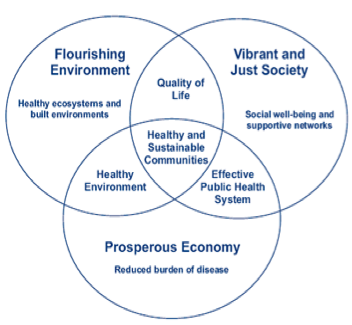Remember! This is only a review. Another course, “APFNet Curriculum 1: Sustainable Forest Management in a Changing World”, is also available if you wish to learn more on SFM.
Sustainable development (SD) has been defined in many ways, but the most frequently quoted definition is from World Conference on Environment and Development (WCED): Our Common Future (1987), also known as the Brundtland Report: “Sustainable development is development that meets the needs of the present without compromising the ability of future generations to meet their own needs”.
It contains two key concepts:
- The concept of needs, in particular the essential needs of the world’s poor, to which overriding priority should be given; and
- The idea of limitations imposed by the state of technology and social organization on the environment’s ability to meet present and future needs.
A better understanding of the idea of SD can be found in a report by the World Conservation Strategy [WCS], which predated the Brudtland Report. The emerging paradigm of SD: “…seeks to develop strategies and tools to respond to five broad requirements”:
- Integration of conservation and development;
- Satisfaction of basic human needs;
- Achievement of equity and social justice;
- Provision of social self-determination and cultural diversity; and
- Maintenance of ecological integrity.
Let us view some images of sustainable development:
All definitions of sustainable development require that we see the world as a system – a system that connects space; a system that connects time; and a system of life quality.
- When you think of the world as a system over space, you grow to understand that air pollution from North America affects air quality in Asia and that pesticides sprayed in Argentina could harm fish stocks off the coast of Australia.
- When you think of the world as a system over time, you start to realize that the decisions our grandparents made about how to farm the land continue to affect agricultural practice today; and the economic policies we endorse today will have an impact on urban poverty when our children are adults.
- We also understand that quality of life is a system, too. It’s good to be physically healthy, but what if you are poor and don’t have access to education? It’s good to have a secure income, but what if the air in your part of the world is unclean? It’s good to have freedom of religious expression, but what if you can’t feed your family?
SD can also be referred to as the relationship between carrying capacity of natural systems with the social challenges facing humanity. SD consists of economic, environment, and social components. This is also referred to as the triple bottom line. All these components are essential and crucial in achieving SD. The concept of sustainable development is rooted in this sort of systems thinking. It helps us understand ourselves and our world. The problems we face are complex and serious—and we can’t address them in the same way we created them. But we can address them.




